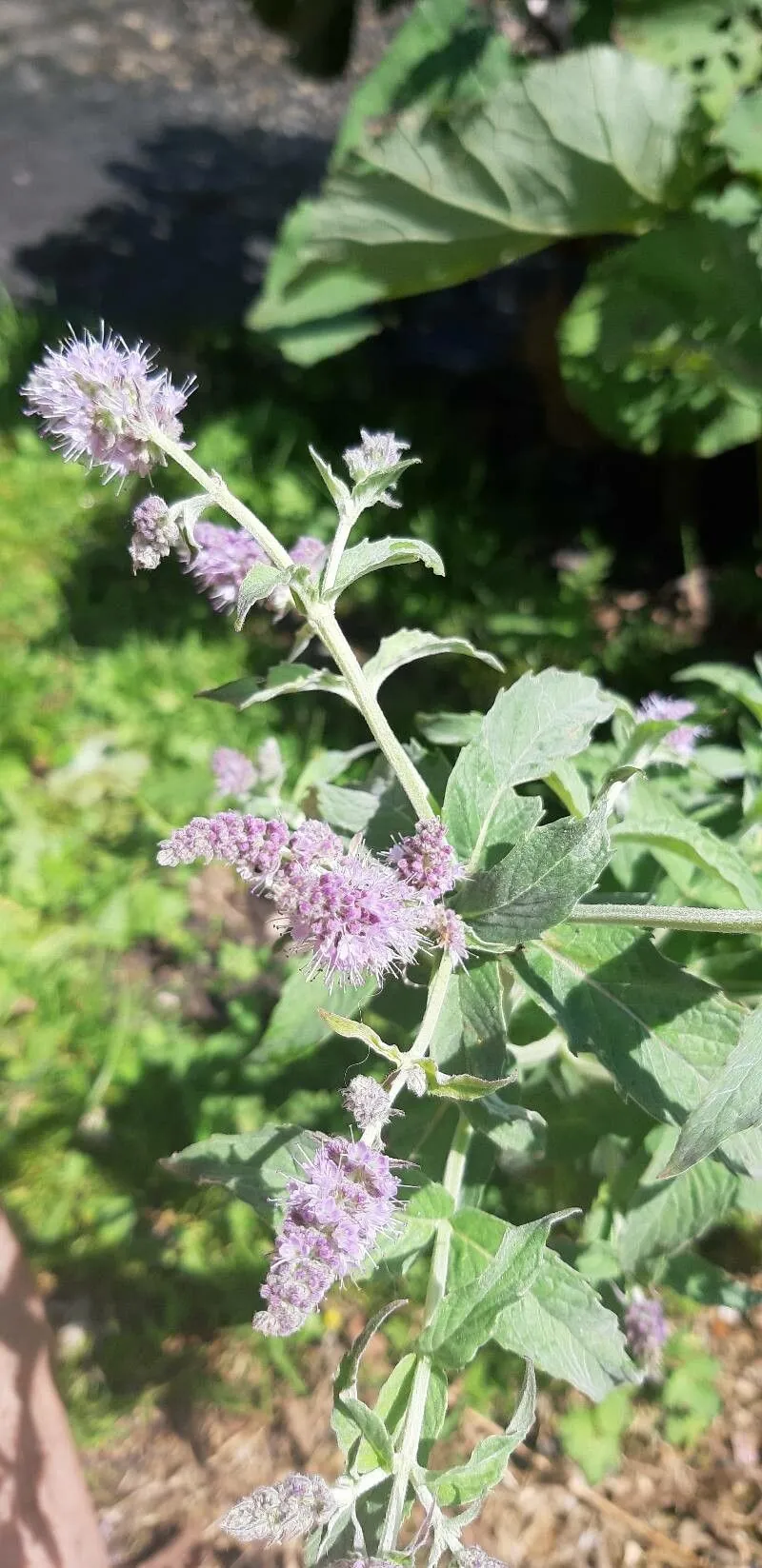
Author: (L.) L.
Bibliography: Amoen. Acad., Linnaeus ed. 4: 485 (1759)
Year: 1759
Status: accepted
Rank: species
Genus: Mentha
Vegetable: False
Observations: Macaronesia, Temp. Eurasia to S. Africa
Horse mint, scientifically recognized as Mentha longifolia, is a notable member of the Lamiaceae family. This aromatic perennial herb is distinguished by its robust and slender stems, which can reach heights of up to 100 cm (39 inches). The plant features elongated, lanceolate leaves that are finely toothed along the edges, typically covered in a gentle layer of fine hairs, giving them a slightly silvery appearance. These textured leaves not only contribute to the plant’s visual appeal but also emit a strong, minty fragrance that is characteristic of many species within the Mentha genus.
Originating from a diverse range of habitats, Horse mint can be found thriving across Macaronesia and temperate regions of Eurasia, extending its reach southwards into parts of Africa. Its adaptability to various climates makes it a versatile plant that can prosper in different environmental conditions, from damp meadows to the edges of forests and riverbanks.
The taxonomy of Mentha longifolia has a rich historical context, first documented in the fourth edition of “Amoenitates Academicae” by Linnaeus in 1759. This historical reference highlights the longstanding recognition and the botanical significance of the species.
Horse mint’s flowers are small and arranged densely in whorled spikes, exhibiting shades of lilac, pink, or even white. These blossoms are not only pleasing to the eye but also attract a variety of pollinators such as bees and butterflies, thus playing an important role in the local ecosystem.
In addition to its ecological value, Mentha longifolia holds potential therapeutic properties. Traditional uses of the plant include various medicinal applications such as treating digestive issues, respiratory conditions, and even serving as a natural antiseptic. The leaves can be used fresh or dried, often brewed into teas or made into essential oils.
Overall, Horse mint is an exemplary species within the mint family, offering a unique blend of aesthetic, ecological, and medicinal benefits. Its widespread occurrence across multiple continents underscores its resilience and adaptability, making it a plant of both historical interest and current relevance in botanical studies.
Deu: ross-minze
Eng: horse mint
Spa: menta selvatica
Fra: menthe sylvestre, menthe à longues feuilles
En: Horse mint, Wild mint, Cape velvet mint, Wild spearmint, Brōcminte, Horsemint
Af: Ballerjan, Kaapse kruisement
Ar: حبق المويه(حَبَق المويه)، حبق الميه (حَبَق الميه), حبقبق (حَبَقْبَق)، حبق البحر (حَبَق البَحْر), نعنع (نَعْنَع)، لمام ( لِمام), نعناع طويل الأوراق
Hy: Անանուխ երկարատերև
Ay: Q’uwa
Be: Мята даўгалістая
Bs: Metvica
Bg: Дълголистна мента
Ca: Menta boscana
Zh: 欧薄荷
Hr: Dugolisna metvica
Cs: Máta dlouholistá
Nl: Hertsmunt
Et: Pikalehine münt
Fi: Harmaaminttu
Fr: Menthe Sylvestre, Menthe à Longues Feuilles
De: Langblättrige Minze, Ross-Minze, Rossminze
He: נענע משובלת
Hu: Lómenta
Kk: Арық жалбыз
Ku: Pûjana ajgulî
Lt: Miškinė mėta
Ps: وېلنی
Fa: نعناپونه
Pl: Mięta długolistna
Ru: Мята длиннолистная
Sr: Коњски босиљак
Sk: Mäta dlholistá
Es: Menta Selvatica
Sv: Gråmynta
Zh-tw: 歐薄荷
Uk: М’ята довголиста
© copyright of the Board of Trustees of the Royal Botanic Gardens, Kew.
© copyright of the Board of Trustees of the Royal Botanic Gardens, Kew.
© copyright of the Board of Trustees of the Royal Botanic Gardens, Kew.
Taken Aug 12, 2022 by Katarzyna Opaska (cc-by-sa)
Taken Jan 16, 2020 by insfran lucas (cc-by-sa)
Taken Aug 13, 2021 by Lucas Judic (cc-by-sa)
Taken Aug 20, 2021 by nalog caribrod (cc-by-sa)
Taken Apr 9, 2020 by marlin milad (cc-by-sa)
Taken Jul 30, 2022 by herbert bacher (cc-by-sa)
Taken Sep 7, 2020 by Sylvie DANGUIN (cc-by-sa)
Taken Jul 16, 2022 by Sara (cc-by-sa)
Taken Aug 28, 2021 by Marek Durajczyk (cc-by-sa)
Taken Aug 7, 2020 by Riveiro Alberto (cc-by-sa)
Taken Sep 4, 2021 by Yekuhl Moss (cc-by-sa)
Taken Jul 27, 2022 by vladimn (cc-by-sa)
Taken Jul 26, 2020 by Werner Rom (cc-by-sa)
Taken Aug 9, 2022 by Anatas (cc-by-sa)
Taken Jul 20, 2022 by J G (cc-by-sa)
Taken Jul 5, 1952 by Royal Botanic Garden Edinburgh – Anonymous (cc-by-nc)
Taken Jul 29, 1952 by Royal Botanic Garden Edinburgh – Anonymous (cc-by-nc)
Taken Jul 20, 2022 by J G (cc-by-sa)
Taken Mar 19, 2021 by Denis Omara (cc-by-sa)
Taken Mar 4, 2020 by Albanese Mattia (cc-by-sa)
Taken Aug 14, 2021 by Luuk van Buul (cc-by-sa)
Taken Aug 6, 2021 by serpentinahermetica (cc-by-sa)
Taken Jun 3, 2021 by serpentinahermetica (cc-by-sa)
Taken Aug 27, 2019 by Denise Flaugnacco (cc-by-sa)
Taken Oct 13, 2021 by Natalia Kazakova (cc-by-sa)
Taken Aug 5, 2022 by Kamil Kunert (cc-by-sa)
Taken Jul 12, 2021 by Przemysław Piotrowicz (cc-by-sa)
Taken Aug 10, 1991 by Royal Botanic Garden Edinburgh – Anonymous (cc-by-nc)
Taken Aug 8, 1936 by Royal Botanic Garden Edinburgh – Anonymous (cc-by-nc)
Ph maximum: 8.0
Ph minimum: 7.5
Light: 7
Atmospheric humidity: 8
Bloom months: [‘jul’, ‘aug’, ‘sep’]
Soil nutriments: 7
Family: Myrtaceae Author: (F.Muell.) K.D.Hill & L.A.S.Johnson Bibliography: Telopea 6: 402 (1995) Year: 1995 Status:…
Family: Rubiaceae Author: Pierre ex A.Froehner Bibliography: Notizbl. Bot. Gart. Berlin-Dahlem 1: 237 (1897) Year:…
Family: Sapindaceae Author: Koidz. Bibliography: J. Coll. Sci. Imp. Univ. Tokyo 32(1): 38 (1911) Year:…
Family: Asteraceae Author: A.Gray Bibliography: Pacif. Railr. Rep.: 107 (1857) Year: 1857 Status: accepted Rank:…
Family: Fabaceae Author: Medik. Bibliography: Vorles. Churpfälz. Phys.-Ökon. Ges. 2: 398 (1787) Year: 1787 Status:…
Family: Aspleniaceae Author: (Cav.) Alston Bibliography: Bull. Misc. Inform. Kew 1932: 309 (1932) Year: 1932…